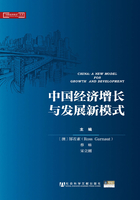
四 结论和政策建议
随着人口年龄结构的变化,15~59岁的劳动年龄人口在2010年停止增长。与此同时,经济增长产生的劳动力需求仍然很大,因此经济增长还在不断吸收农业中的剩余劳动力。当农业中的剩余劳动力开始减少,中国经济就进入了一个转型阶段,从过去的二元经济发展向新古典增长转变。
根据新古典增长理论,发达经济体的经济增长率不可能与发展中国家相比,因为发展中国家仍然处于赶超过程。当一个经济体达到一定的转折点时,快速的经济增长最终将会放缓,在世界范围内这已被证实(Eichengreen等,2011)。
实际上并不需要担心潜在增长率开始下降。然而,新的发展阶段需要中国的经济发展模式完成一个基本的转型,从过去单纯依赖资本和劳动力投入转向促进和提高潜在增长率。因此,可持续经济增长的关键在于扩大那些影响潜在增长率的供给方因素。如果政府的政策错误地盯住那些需求方因素,试图通过刺激需求因素使实际增长率超过潜在增长率,那么长期的经济增长会出现非健康和扭曲现象。相反,应该采取一些合理的政策措施并牢记如下几点。
第一,中央和地方政府应该接受经济增长开始下降的事实。政策决定应该盯住供给方要素,而不是需求方要素。即使出现了对需求方要素的冲击所导致的经济增长放缓,政策制定者也不应该有理由采取宏观政策措施。相反,政策制定者需要关注是否增长率已经降低到了潜在增长率之下。如果并没有出现这种情况,出口需求和投资需求下降将成为经济向消费驱动模式加速转型和经济平衡发展的契机。
第二,经济改革应该重构传统的经济增长模式。在过去30年的高速经济增长过程中,改革是一个主要的驱动因素。竞争环境对提高中国未来10年的潜在增长率至关重要。
第三,在提高TFP的过程中,政府发挥了重要的作用。Krugman(1994)批评新加坡增长模式。新加坡政府通过在全国范围内引入每年2%的TFP增长率目标作为对克鲁格曼的回应(Felipe, 1997)。事实上,提高TFP也将同样依赖中国的进一步改革。
参考文献
Bai, Chong-En, Chang-Tai Hsieh and Yingyi Qian, 2006, “The Return to Capital in China”, NBER Working Paper No. w12755, National Bureau of Economic Research, Cambridge, MA.
Bloom, David E. and Williamson Jeffrey G. , 1998, “Demographic Transitions and Economic Miracles in Emerging Asia”, World Bank Economic Review, Vol.12, No.3, pp. 419-55.
Cai, Fang and Zhao Wen, 2012, “When Demographic Dividend Disappears: Growth Sustainability of China”, in Masahiko Aoki and Jinglian Wu, eds. , The Chinese Economy: A New Transition, Basingstoke: Palgrave Macmillan.
CDRF(China Development Research Foundation), 2012, China Development Report, 2012, Beijing: China Development Publishing House.
CHINA STATISTICAL YEARBOOK, Compiled by National Bureau of Statistics of China, Beijing, China.
CHINA YEARBOOK OF RURAL HOUSEHOLD SURVEY, Compiled by Rural Social and Economic Survey Office of the State Statistics Bureau, Beijing, China.
CHINA POPULATION STATISTICS YEARBOOK, Compiled by Department of Population, Social, Science and Technology Statistics National Bureau of Statistics of China, Beijing, China.
Du, Yang and Hu Ying, 2011, “Working Age Population and Labor Force Supply”, Working Paper of Institute of Population and Labor Economics. http://iple.cass.cn/news/655101.htm.
Du, Yang and Lu Yang, 2011, “The Natural Rate of Unemployment in China and Its Implications”, The Journal of World Economy, Vol.34, No.4, pp.3-21.
Eichengreen, Barry, Donghyun Park and Kwanho Shin, 2011, “When Fast Growing Economies Slow Down: International Evidence and Implications for China”, NBER Working Paper No.16919, National Bureau of Economic Research, Cambridge, MA.
Felipe, Jesus, 1997, “Total Factor Productivity Growth in East Asia: A Critical Survey”, EDRC Report Series, No.65, Asian Development Bank, Manila, Philippines.
Foster, Lucia, John Haltiwanger and Chad Syverson, 2008, “Reallocation, Firm Turnover, and Efficiency: Selection on Productivity or Profitability? ”American Economic Review, Vol.98, No.1, pp.394-425.
Garnaut, Ross(2010), “Macro-economic Implications of the Turning Point”, China Economic Journal, Vol.3, No.2, pp.181-190.
Guo, Qingwang and Junxue Jia, 2004, “Estimating Potential Output and the Output Gap in China”, Economic Research Journal, No.5, pp.31-39.
Hsieh, Chang-Tai and Peter J. Klenow, 2007, “Misallocation and Manufacturing TFP in China and India”, NBER Working Paper, No.13290, National Bureau of Economic Research, Cambridge, MA.
Kharas, Homi, 2011, “China's Transitions to a High Income Economy: Escaping the Middle Income Trap”, in Lim Edwin and Michael Spence, eds. , The Medium and Long Term Development and Transformation of the Chinese Economy: An International Perspective, Beijing:CITIC Publishing House, pp.470-501(in Chinese).
Krugman, Paul, 1994, “The Myth of Asia's Miracle”, Foreign Affairs, Vol.73, No.6, pp.62-78.
Kuijs, Louis and Tao Wang, 2006, “China's Pattern of Growth, Moving to Sustainability and Reducing Inequality”, China and World Economy, Vol.14, No.1, pp.1-14.
Kuijs, Louis, 2009, “China Through 2020—A Macroeconomic Scenario”, World Bank China Office Research Working Paper, No.9, World Bank China Office, Beijing.
Lu, Yang, 2012, “China's Natural Growth Rate of Output and Its Forecast”, in Cai Fang, ed. , The China Population and Labor Yearbook No.13: Demographic Transition and Economic Rebalance in China, Social Sciences Academic Press, China, pp.98-111.
Wang, Guangzhou and Jianlin Niu, 2010, “Composition and Development of the Chinese Education System”, in Cai Fang, ed. , The China Population and Labor Yearbook Volume 2: The Sustainability of Economic Growth from the Perspective of Human Resources, Leiden Boston:Brill, pp.43-62.
Williamson, Jeffrey G. , 1998, “Growth, Distribution, and Demography: Some Lessons from History”, Explorations in Economic History, Vol.35, No.3, pp.241-71.
World Bank, 2012, “China 2030 Building a Modern, Harmonious, and Creative High-Income Society”(online; cited November 2012). Available from: http://www.worldbank.org.
(陆旸 译)